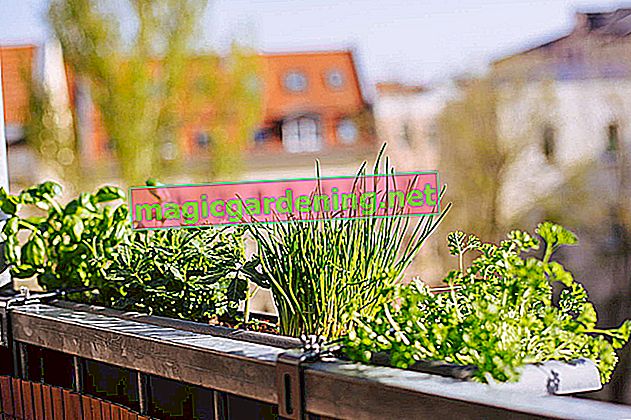
The right location
The majority of herbs prefer a sunny, warm and sheltered place. If the balcony garden is too drafty, protective railings or low protective hedges (for example made from semi-shrubs such as lavender, sage or rue) can help. It is ideal if the fall protection of the balcony is not made of solid stone, but of translucent glass / plastic or a grid. Some herbs also feel better in a partially shaded place. This is especially true for the species that grow in forests or on the edges of forests - typical examples are wild garlic and woodruff.
also read
- The right way to create a herb garden - instructions to make yourself
- Maintain and overwinter a herb garden in a pot properly
- The optimal care for the herb garden
The right earth
Herbs sometimes have very different demands on the soil in which they grow. For cultivation and propagation you should definitely use seed compost, for further cultivation, in most cases, sufficiently fertilized potting soil is recommended. Mediterranean herbs such as rosemary, thyme or sage love drought and need poor, well-drained soil. In this case, sand is added to the potting soil. Herbs like lemon balm or peppermint, on the other hand, love it more humid; For these plants you need a structurally stable soil that does not mold much.
Choice of planters
Sufficiently large planters are also a very important prerequisite for the healthy growth of plants. These are available in different sizes, shapes and materials, whereby the size of the required pots can easily be derived from the expected size of the plant. As a rule of thumb, the root volume of a plant is hardly less than the associated aboveground plant parts. This means that for a 40 to 60 centimeter high plant you need a container with a diameter of approx. 20 centimeters.
Which is better: natural materials or plastic?
Clay pots, wooden or ceramic vessels, baskets and window boxes are particularly suitable. (€ 106.25 at Amazon *) When using plastic containers, you should make sure that the roots of the plants can be adequately ventilated. In order to avoid waterlogging that is harmful to the herbs, the vessels in the bottom must have sufficiently large drainage holes.
Ideas for the design of the pot garden
A potted herb garden on the balcony can be designed in many ways. Particularly interesting is a colorful mixture of herbs that can be planted together in a balcony box or in pocket pots or arranged on weatherproof wall shelves. The herb pots are also well presented if you place them on different levels rather than on one level. On the other hand, a colored potted herb garden with green, silver or red-leaved species looks a bit more formal. Sorting according to possible use can also be useful - for example according to tea and aromatic herbs, edible leaves and flowers for decoration.
This is how it is planted
The holes in the bottom of the pots are covered with pebbles or pottery shards. Then fill the pots halfway with soil and place the young plants there. Now you can fill the containers with soil to the brim and press down firmly. In addition, press in a small watering edge, through which the watering water will later be directed to the roots. Don't forget to give the freshly planted herbs a lot of water - this will make it easier for the roots to grow.
Proper care of the pot garden
Plants need regular water during the growing season. It makes sense to let the bale almost dry out and only then to water it thoroughly. In this way the roots are evenly supplied with water and air, and you can also prevent overwatering more easily. From about four weeks after potting, the herbs should be fertilized regularly with liquid fertilizer. To do this, use special herbal fertilizers from specialist retailers, which you dose according to the instructions, add to the irrigation water and usually apply once a week. Instead, you can make your own vegetable stock from nettles, field horsetail and / or comfrey. It contains nitrogen, potassium and many trace elements - but it smells pretty bad when it is made.However, you can soften the strong smell by adding rock flour (€ 14.95 at Amazon *), which also provides additional nutrients.
Repot potted plants
Some herbs - such as basil - are only cultivated as an annual. Of course, you don't need to repot here, instead you sow the offspring anew every year. Plants such as lavender, rosemary or lemon bush, however, which remain in the same tub every year, need some fresh soil every year. To do this, the top soil layer is replaced. If that is no longer possible or the plant pot has become too small due to the growth, you should repot the plant soon. Spring is the best time for this. The new vessel should be at least four centimeters larger in diameter than the old one.
Hibernate potted herbs properly
Perennial herbs that are sensitive to frost are best spent indoors. Frost-free, bright rooms such as the stairwell, a winter garden or a suitable cellar are suitable for this. If, on the other hand, pots with sensitive herbs are to be overwintered on the balcony, they must be well packed and placed against the heat-radiating wall of the house and on wooden blocks or a styrofoam pad.
Tips
Only plant herbs together in a planter that have similar requirements for sun, water and nutrients.








